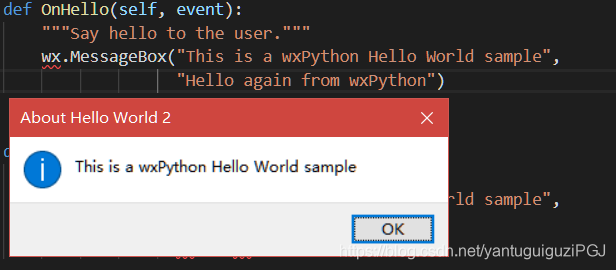wxpython的Hello,World代码探索
本文共 3492 字,大约阅读时间需要 11 分钟。
python界面编程资料
#!/bin/python"""Hello World, but with more meat."""import wxclass HelloFrame(wx.Frame): """ A Frame that says Hello World """ def __init__(self, *args, **kw): # ensure the parent's __init__ is called super(HelloFrame, self).__init__(*args, **kw) # create a panel in the frame pnl = wx.Panel(self) # and put some text with a larger bold font on it st = wx.StaticText(pnl, label="Hello Friend!", pos=(500,260)) font = st.GetFont() font.PointSize += 50 font = font.Bold() st.SetFont(font) # create a menu bar self.makeMenuBar() # and a status bar self.CreateStatusBar() self.SetStatusText("Welcome to wxPython100!") def makeMenuBar(self): """ A menu bar is composed of menus, which are composed of menu items. This method builds a set of menus and binds handlers to be called when the menu item is selected. """ # Make a file menu with Hello and Exit items fileMenu = wx.Menu() # The "\t..." syntax defines an accelerator key that also triggers # the same event helloItem = fileMenu.Append(-1, "&Hello...\tCtrl-H", "Help string shown in status bar for this menu item") fileMenu.AppendSeparator() # When using a stock ID we don't need to specify the menu item's # label exitItem = fileMenu.Append(wx.ID_EXIT) # Now a help menu for the about item helpMenu = wx.Menu() aboutItem = helpMenu.Append(wx.ID_ABOUT) # Make the menu bar and add the two menus to it. The '&' defines # that the next letter is the "mnemonic" for the menu item. On the # platforms that support it those letters are underlined and can be # triggered from the keyboard. menuBar = wx.MenuBar() menuBar.Append(fileMenu, "&File") menuBar.Append(helpMenu, "&Help") # Give the menu bar to the frame self.SetMenuBar(menuBar) # Finally, associate a handler function with the EVT_MENU event for # each of the menu items. That means that when that menu item is # activated then the associated handler function will be called. self.Bind(wx.EVT_MENU, self.OnHello, helloItem) self.Bind(wx.EVT_MENU, self.OnExit, exitItem) self.Bind(wx.EVT_MENU, self.OnAbout, aboutItem) def OnExit(self, event): """Close the frame, terminating the application.""" self.Close(True) def OnHello(self, event): """Say hello to the user.""" wx.MessageBox("This is a wxPython Hello World sample", "Hello again from wxPython") def OnAbout(self, event): """Display an About Dialog""" wx.MessageBox("This is a wxPython Hello World sample", "About Hello World 2", wx.OK|wx.ICON_INFORMATION)if __name__ == '__main__': # When this module is run (not imported) then create the app, the # frame, show it, and start the event loop. app = wx.App() frm = HelloFrame(None, title='Hello World 100') frm.Show() app.MainLoop() super()的解释
fileMenu.AppendSeparator()
这个函数是在两个子选项之间添加分隔符
MessageBox的标题是逗号后面的那句,消息内容是第一句。

wx.OK|wx.ICON_INFORMATION
红色矩形框,这一句少了会报错

不加到最后一个OnAbout也不行

每句都加也不行

只能加到最后一句
helloItem = fileMenu.Append(-1, "&Hello...\tCtrl-H",
"Help string shown in status bar for this menu item")
-1可以,-2可以,-3可以,-4不行,-4以下都不行。0---10000可以


转载地址:http://klywz.baihongyu.com/
你可能感兴趣的文章
Nginx代理访问提示ERR_CONTENT_LENGTH_MISMATCH
查看>>
Nginx代理配置详解
查看>>
Nginx代理静态资源(gis瓦片图片)实现非固定ip的url适配网络环境映射ip下的资源请求解决方案
查看>>
Nginx代理静态资源(gis瓦片图片)实现非固定ip的url适配网络环境映射ip下的资源请求解决方案
查看>>
nginx优化日志拒绝特定404请求写入
查看>>
Nginx优化解析
查看>>
Nginx使用proxy_cache指令设置反向代理缓存静态资源
查看>>
Nginx做反向代理时访问端口被自动去除
查看>>
Nginx入门教程-简介、安装、反向代理、负载均衡、动静分离使用实例
查看>>
Nginx入门简介和反向代理、负载均衡、动静分离理解
查看>>
nginx入门篇----nginx服务器基础配置
查看>>
nginx反向代理
查看>>
Nginx反向代理
查看>>
nginx反向代理、文件批量改名及统计ip访问量等精髓总结
查看>>
Nginx反向代理与正向代理配置
查看>>
Nginx反向代理及负载均衡实现过程部署
查看>>
Nginx反向代理和负载均衡部署指南
查看>>
Nginx反向代理是什么意思?如何配置Nginx反向代理?
查看>>
nginx反向代理解决跨域问题,使本地调试更方便
查看>>
nginx反向代理转发、正则、重写、负摘均衡配置案例
查看>>